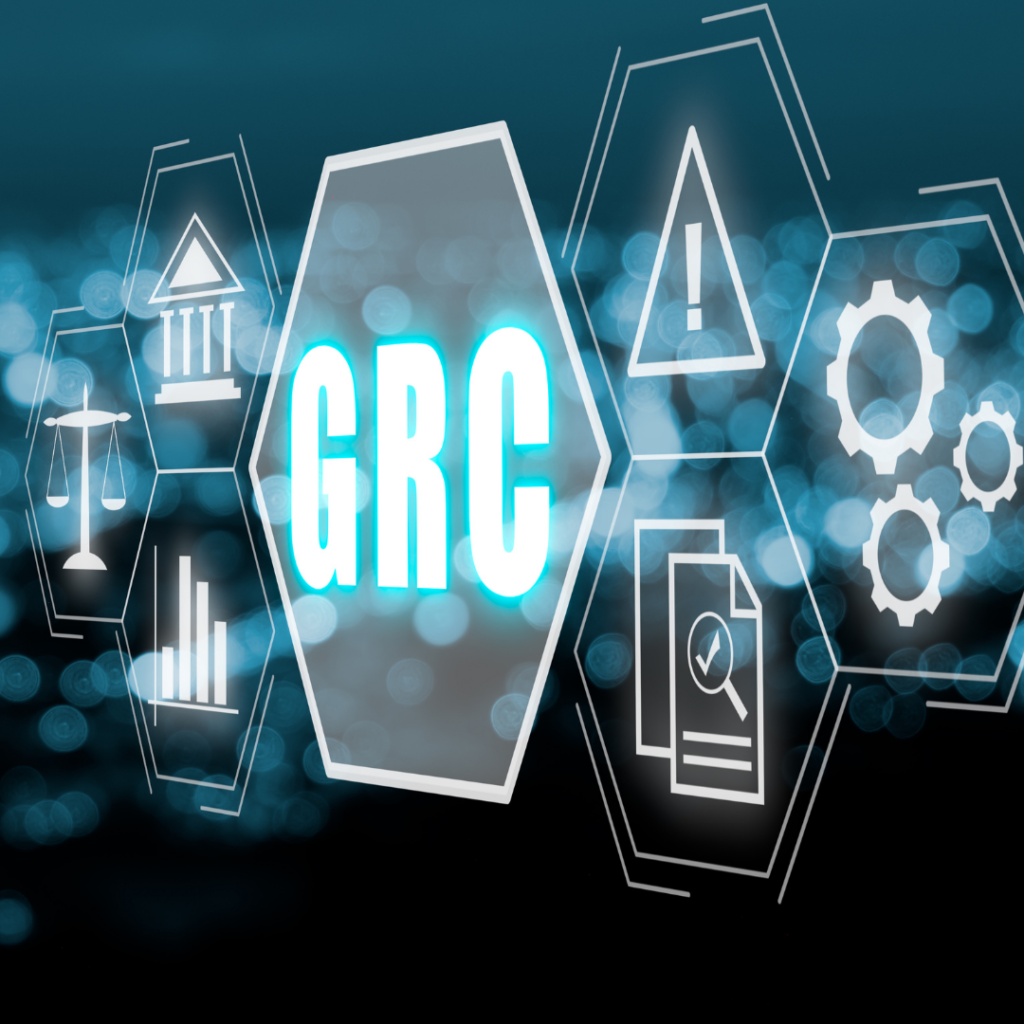
Art Clomera
Vice President, Operations
Most organizations succeed (or falter) based on the information they keep and the sophistication with which they can manage it. It’s why having the right GRC tools in place to help manage governance, risk management, and compliance (GRC) issues around information has become a standard organizational strategy.
While CISOs face the challenge of aligning GRC with cybersecurity to gain control over digital assets, they’re often hindered by budget and personnel constraints and the reality that no single GRC tool can do it all.
Selecting the right GRC tool becomes critical in navigating these challenges and enhancing overall efficiencies. Often it involves thorough consideration and teamwork among business, IT, and compliance departments. All this demands time, effort, and financial resources, so a strategic choice is essential. We’re exploring the top GRC tools of 2025 with these considerations in mind.
What are GRC tools?
GRC tools leverage frameworks and methodologies like the NIST Cybersecurity Framework to manage cybersecurity risks, compliance, and governance systematically. By combining GRC and cybersecurity, organizations can build a long-term security strategy while minimizing manual input, reducing costs, and gaining visibility into the organization’s security posture.
For instance, the NIST Framework outlines steps for identifying, protecting, detecting, responding, and recovering from cybersecurity incidents. GRC tools integrate these steps into their functionality, allowing organizations to assess their cybersecurity posture, identify gaps, and implement necessary measures.
Read more: What is GRC in cybersecurity?
Industries that use GRC tools
GRC tools are critical across multiple industries, especially in sectors subject to stringent regulations. This includes biotech, life sciences, energy, utilities, financial services, food and beverage, government sectors, insurance, healthcare, higher education, manufacturing, retail, technology, transportation, and logistics.
From government agencies to non-profits, the benefits of GRC tools extend far beyond their initial focus on governance, risk, and compliance. Their ability to streamline processes, improve decision-making, and reduce operational costs makes them invaluable for organizations of all sizes and across diverse industries.
Industries requiring GRC tools include:
- Governments
- Financial services
- Healthcare
- Technology
- Manufacturing and Retail
- Energy and utilities
- Technology and telecommunications
- Universities and colleges
Why do Government agencies need GRC tools?
Government agencies at all levels, from federal to local, rely heavily on GRC tools to navigate the complex and ever-changing landscape of public administration.
How are GRC Tools used in federal agencies?

Navigating the GRC Landscape: Top GRC Tools for 2025
GRC platforms integrate organizational processes and tools into a single hub for managing governance, risk, and compliance (GRC). To qualify as a GRC compliance software, it must have the following capabilities:
- Analyze, categorize, and mitigate risks across the ecosystem
- Enable employees, auditors, and stakeholders to share information and communicate policies
- Ensure compliance specific to the industry or framework
- Offer business continuity and disaster management capabilities
- Review and assess third-party stakeholders for risks
- Train employees with relevant awareness programs
- Provide tools to analyze, detect, mitigate, and document risks
The 8 best GRC tools for 2025

1. Tenable Nessus
Best for security-focused organizations seeking thorough vulnerability assessments and effective threat management.

Tenable Nessus: Introduction to the Tool
Tenable Nessus is widely recognized as the industry’s leading vulnerability assessment solution for modern attack surfaces. It extends beyond traditional IT assets by fortifying web applications, allowing visibility into your internet-connected attack surface, and securing cloud infrastructure.
Tenable Nessus: Key Features and Functionalities
Tenable Nessus is a leading vulnerability scanner and assessment platform organizations of all sizes use to identify and remediate IT infrastructure vulnerabilities.
Features:
- Comprehensive vulnerability scanning
- Accurate reporting on vulnerabilities
- Customizable scans
- Automated remediation
- Scalable to meet the needs of various organizations
- Wide range of integrations
- User-friendly interface
Vulnerability Scanning
- Extensive coverage: Identifies vulnerabilities across operating systems, applications, network devices, cloud platforms, and more
- Multiple scanning methods: Supports various scan types like credentialed, agent-based, and web application scanning for comprehensive coverage
- Advanced detection: Employs multiple detection techniques, including vulnerability signatures, exploit code, and network traffic analysis, to detect even the latest vulnerabilities
- Prioritization and risk scoring: Prioritizes vulnerabilities based on their severity, exploitability, and potential impact, allowing you to focus on the most critical ones first
Vulnerability Assessment
- Detailed reporting: Provides detailed reports on identified vulnerabilities, including their description, potential impact, recommended remediation steps, and references to relevant security advisories
- Vulnerability tracking: Tracks the status of identified vulnerabilities, allowing you to monitor progress on remediation efforts
- Compliance mapping: Maps vulnerabilities to applicable compliance standards and regulations, simplifying compliance reporting and audits
- Integration with other security tools: Interfaces with additional security solutions, including intrusion detection systems and firewalls
Additional Features:
- Asset Discovery: Identifies and inventories all IT assets on your network, providing a comprehensive view of your attack surface
- Misconfiguration Management: Detects and reports on system misconfigurations that could introduce security vulnerabilities
- Patch Management: Helps manage the patching process by identifying vulnerable systems, recommending patches, and tracking patch deployment
- Threat Intelligence: Provides access to real-time threat intelligence feeds to stay ahead of emerging vulnerabilities and cyberattacks
👍 Pros | 👎 Cons |
Performs comprehensive vulnerability scans, providing accurate findings | Potential to generate false positives, wasting time and resources |
Easy-to-deploy and easy-to-use | Limited reporting customization capabilities |
Advanced detection for more protection | Not a complete security solution, requiring integration with other security tools |
Cost-effective for companies of all sizes | Can be expensive, especially for small businesses |
Accurate visibility into security posture | Complex to set up and configure, which may require the assistance of a security professional |
Tenable Nessus: User reviews
G2: 8.9/10 TrustRadius: 8.6/10
2. eMASS
Best suited for organizations, particularly within the DoD, needing a comprehensive and integrated solution for cybersecurity management.

eMASS: Introduction to the Tool
eMASS (Enterprise Mission Assurance Support Service) is a web-based Government off-the-shelf (GOTS) tool that makes it easily accessible and scalable for organizations. It automates controls scorecard measurement, dashboard reporting, and the generation of Risk Management Framework (RMF) and DoD Information Assurance Certification and Accreditation Process (DIACAP) Package Reports.
eMASS: Key Features and Functionalities
The Defense Information Systems Agency (DISA) manages eMASS’s core functionality, ensuring high trust and reliability for organizations using the solution.
eMASS automates a broad range of comprehensive, fully integrated cybersecurity services, addressing various aspects of an organization’s security needs.
- Automated Authorization to Operate (ATO) Process: Streamlines the RMF process for DoD IT
- Controls Management: Centralized system for managing security controls
- Risk Assessment and Management: Tools for identifying and mitigating cybersecurity risks
- Compliance Tracking: Adhere to DoD-specific cybersecurity standards and regulations
- Dashboard Reporting: Real-time insights into cybersecurity posture and compliance status
- Document Management: Facilitates the organization and storage of essential cybersecurity documentation
- User Access Controls: Secure and role-based access to sensitive information and systems
- Controls scorecard measurement: Effectively assess and manage their cybersecurity risks
- Generates system security authorization package: Maintain compliance and ensure the security of an organization’s information system
👍 Pros | 👎 Cons |
Automates customizable workflow for managing essential security functions at the enterprise level | Individual class seats can only be purchased for training in specific locations, and training in other locations is only scheduled for group class purchases |
Provides a broad range of services for comprehensive, fully integrated cybersecurity management | The tool may not be as user-friendly as desired |
Features include dashboard reporting, controls scorecard measurement, and the generation of a system security authorization package |
|
eMASS: User reviews
Currently, the only federal civilian agency using eMASS is the Department of Veterans Affairs. Therefore, no consumer reviews are available. But feel free to contact us if you’d like to know more or dive into this eMASS Reddit thread.
3. Xacta

Xacta: Introduction to the Tool
Xacta is an IT and cyber risk management platform designed to help organizations manage risk with intelligent workflow, automation, and continuous compliance monitoring. It offers centralized management for enterprise security intelligence and streamlining compliance processes for leading government and industry standards and frameworks.
Xacta: Key Features and Functionalities
This GRC solution enables organizations to continuously manage their cyber risk and security compliance initiatives, reducing time to compliance and automating security test plans. Large government agencies use it as their standard enterprise solution for continuous security.
- Compliance Audit Software: Analyzes IT asset information collected from various systems, including workloads hosted on AWS cloud.
- Identifies, monitors, evaluates, and assists in mitigating security risks from individual systems to the enterprise level
- Supports frameworks across industries with no-code customization
- Reduces audit fatigue with control mapping optimized for cloud security assessments and deployments
- Intelligent Workflow and Documentation: Data-driven decisions from hiding or revealing information to implementing an approval process or automating risk evaluations and acceptance
- Continuous Control Monitoring: Allows the assignment of control expirations and automatic notifications to the control owner or other relevant personnel
- Risk Analysis and Reporting: Users can use the default risk scoring system or create a custom algorithm. The application allows any data field to be converted into a value for risk reporting, accessible within the app or exportable to a corporate risk system via API
- Auto Test Plan Generation: Generates customizable and granular test plans that can be segmented by various operating systems, asset types, and more
- Control Inheritance: Robust inheritance features help organizations capture the multiple layers of security by inheriting pre-validated controls from other typical applications, systems, and networks
- Cyber Risk Management Platform: Manages key aspects of over 100 major IT security regulations and policies, encompassing NIST RMF, RMF for DoD IT, CNSS 1253, NIST CSF, and FedRAMP
- User Training: User training courses covering core user functionalities, asset management, vulnerability management, dashboard overview, and working with Xacta 360
Xacta: Usability and Interface
Feedback from users indicates that Xacta’s interface is user-friendly, simplifying navigation and its features. This ease of use enhances the overall user experience, particularly valuable for managing the complexities of compliance and risk management tasks.
👍 Pros | 👎 Cons |
Comprehensive cyber risk management solution for continuous security risk assessment, compliance automation, and management | Users report limitations in customizing reports beyond pre-configured formats, which may only meet some reporting needs |
Reduces the time required for re-assessments by up to 60% | Various plans and customization options make predicting costs challenging |
Offers a customizable and granular test plan that various operating systems, asset types, and more can segment |
|
Xacta: User reviews
Gartner: 3.7/5
4. Archer
Best for organizations seeking a comprehensive GRC solution offering extensive governance, risk management, and compliance features.

Archer: Introduction to the Tool
Archer is a leading integrated risk management (IRM) software provider, offering a comprehensive platform to manage risk, compliance, and audit processes. Founded in 2000, Archer has established itself as a trusted partner for large enterprises and government agencies.
Archer: Key Features and Functionalities
- Integrated Risk Management: Comprehensive approach to integrated risk management, offering a modern, tailored platform designed to drive efficiency and coordination across stakeholders
- Common Understanding of Risk: By applying the same taxonomies, policies, and metrics to manage all risk data, enhancing visibility, improving collaboration, and increasing efficiencies
- Consolidated Compliance and Assurance: A central aggregation point supporting an organization’s risk management program, allowing the consolidation of compliance and assurance activities into a single strategy
- Streamlined User Experience: For business operations and vendors through the Archer Engage module, facilitating intuitive user experience, essential data capture, and stakeholder participation
- Document Management: Organizes and tracks GRC-related documents and artifacts, ensuring easy access and version control
- Configurability and Integration: Because the out-of-the-box solutions are built on Archer, users can configure them and integrate them with multiple data sources without custom coding
- Comprehensive Feature Set: Range of features and capabilities, including alerts/notifications, audit management, compliance management, dashboard, disaster recovery, IT risk management, and operational risk management
Archer: Pricing and Plans
Archer offers a subscription-based pricing model with various tiers based on features, user count, and deployment options. Working out your exact cost will depend on your specific needs and configuration.
👍 Pros | 👎 Cons |
Customizable platform with a high degree of flexibility | Challenges in retrieving data and generating reports |
Neat user interface with the ability to customize reports and generate statistical data | Documentation for administrators could be more in-depth |
Enterprise-wide accessibility | Challenges in retrieving data and generating reports |
Customizable to suit agency needs |
|
Accessible by all employees in the organization |
|
Archer: User Feedback and Ratings
5. Onspring GovCloud
Best for federal agencies seeking a secure, compliant, and scalable cloud-based platform for collaborative reporting and connected data.

Onspring GovCloud: Introduction to the Tool
Onspring GovCloud GRC is a purpose-built platform to streamline GRC for federal agencies. Launched in 2013, Onspring has established itself as a dedicated solution, catering to the unique needs and regulations of the government sector.
Onspring GovCloud: Key Features and Functionalities
Onspring GovCloud GRC is a 100% no-code, SaaS cloud-based GRC platform that is FedRAMP Authorized, providing a secure and reliable solution for federal agencies. It offers a streamlined, cloud-based platform that brings together the entire ecosystem of GRC, enabling federal agencies to identify, protect, detect, respond, and recover in a secure and connected environment.
- OMB A-123 Risk & Controls Software: Offers POA&M Management and a comprehensive Governance, Risk & Compliance (GRC) suite designed for federal agencies, including OMB A-123 Risk & Controls software
- Cloud-based GRC software platform: No-code, cloud-based platform enables risk reduction and compliance efficiencies to federal notifications and real-time analytics
- Comprehensive GRC suite: Includes live dashboards of critical metrics, risk scores, audit activity status, and more
- Customizable workflows: Customize workflows, triggers, and integrations with no-code admin when processes change and the agency needs to shift
- Secure and personalized workspace: Secure, customized workspace for internal users and external partners to collaborate on GRC programs
- Compliance with industry standards: Onspring is STAR Level One with the Cloud Security Alliance (CSA) and maintains a SOC2 Type II attestation annually
- FedRAMP In-Process: At a moderate level
Onspring GovCloud: Pricing and Plans
Detailed pricing and plans for Onspring GovCloud GRC are not readily available and may require direct engagement with the vendor for a customized quote.
👍 Pros | 👎 Cons |
Secure, compliant, and scalable platform for collaborative reporting and connected data for government agencies | Less flexibility for agencies with specific needs beyond core functionalities |
Robust set of secure, connected programs, ready-made for federal agencies, with the ability to customize workflows, triggers, and integrations | Individual class seats can only be purchased for training in specific locations, and training in other locations is only scheduled for group class purchases
|
Flexible, no-code platform for GRC, ITSM, audit, risk, compliance, and business operations | May need effort to integrate with existing agency systems. |
Hands-on labs and training courses for eMASS administrators |
|
Onspring GovCloud: User Feedback and Ratings
G2: 4.8/5
6. MetricStream
Best for organizations seeking a unified, comprehensive, and integrated GRC platform.

MetricStream GRC: Introduction to the Tool
The MetricStream GRC Platform, based in Palo Alto, California, offers a Governance, Risk Management, and Compliance (GRC) platform. This veteran platform has evolved into a robust ecosystem, connecting risk, compliance, audit, and cybersecurity under one umbrella.
MetricStream GRC: Key Features and Functionalities
- Connected GRC Platform: Enables organizations to pursue an integrated approach to GRC and ensure collaboration between risk, compliance, audit, cybersecurity, and sustainability teams
- Comprehensive GRC Suite: Single, scalable platform providing a comprehensive mapping of the GRC framework
- Regulatory Compliance and Policy Management: Common framework and support for NERC, OFAC, and regional standards
- Risk Management: Manage risks, including enterprise risk management (ERM), operational risk management (ORM), IT and cyber risks, third-party risks, compliance risks, and ESG risks
- BusinessGRC: Manage, coordinate, and track multiple GRC activities
- CyberGRC and ESGRC: Manage IT-related risks and compliance requirements (CyberGRC) and streamline all organizational requirements relating to ESGRC
MetricStream GRC: Usability and Interface
MetricStream’s interface is customizable and user-friendly, catering to technical and non-technical users. Role-based permissions and interactive dashboards ensure everyone accesses the information and tools they need, while advanced features offer deeper customization for experienced users.
👍 Pros | 👎 Cons |
Easy to navigate | Lack of availability of executive dashboards, especially in the Compliance/Survey module |
Speed/efficiency | Limited functionality of charts and graphs |
Secure, compliant, and scalable platform for collaborative reporting and connected data for government agencies |
|
Robust set of secure, connected programs, ready-made for federal agencies, with the ability to customize workflows, triggers, and integrations |
|
MetricStream GRC: User Feedback and Ratings
Gartner: 4.2/5
7. Hyperproof
Best for federal agencies seeking to comply with the FedRAMP (Federal Risk and Authorization Management Program) requirement.

Hyperproof: Introduction to the Tool
Born in 2015, Hyperproof is a cloud-based platform that champions agility and efficiency, leveraging AI to streamline compliance, automate tasks, and empower organizations to embrace a proactive approach to risk management. Forget endless spreadsheets and manual processes; Hyperproof injects intelligence into GRC, bringing clarity and control to the chaos.
Hyperproof: Key Features and Functionalities
Hyperproof, a compliance operations platform, offers a range of critical features and functionalities that empower organizations to streamline compliance and risk management processes.
- Record-Keeping: Single source of truth, allowing you to house all infosec compliance requirements and standard frameworks, controls universe, and evidence
- Planning: Plan information security, data privacy, and compliance projects, execute them, monitor progress, and keep records
- Workflow optimization and automation: Reduce time spent on manual tasks by up to 70%
- Reporting and monitoring: Real-time analytics allows your team to know precisely where they should spend their time and energy
- Scaling: Scale up information security compliance programs and map control to multiple requirements
- Custom Reporting Service: For more meaningful reporting
- Controls-Hierarchy feature: Enables organizations with multiple product teams to manage and share standard information and overall health at the parent control level that is shared
- Over 60 Supported Compliance Frameworks Out-of-the-Box: Easier to keep up with new regulations and standards
- Advanced Analytics: Including real-time dashboards, predictive analytics, and scenario modeling for informed decision-making
Hyperproof: Pricing and Plans
Hyperproof offers a subscription-based pricing model with tiered plans based on features, user count, and deployment options (cloud or hybrid).
👍 Pros | 👎 Cons |
Provides support in helping organizations mature their compliance programs | Limited availability of executive dashboards, especially in the Compliance/Survey module |
Simplifies the compliance process and reduces expenses by offering pre-built starter templates | Reporting capabilities are currently lacking, though the company is actively developing better solutions |
Centralizes evidence collection by providing a secure platform for collaboration | The product fell short in automating evidence collection, particularly in terms of SaaS integrations for automation purposes |
Offers a customer-oriented support team that successfully addresses business needs | Initial cloud integration fell short compared to competitors but has seen vast improvements over the last year |
The software is recommended for its simplicity and adaptability |
|
Hyperproof: User Feedback and Ratings
8. IPKeys CLaaS
Best for: Federal agencies requiring advanced analytics and risk management within their cybersecurity frameworks.

More than just reporting: Automatically generate POA&Ms and calculate the Rough Order of Magnitude to mitigate vulnerabilities.
IPKeys ClaaS: Introduction to the Tool
IPKeys ClaaS (Cyber-Lab-as-a-Service) is a cutting-edge tool designed with the complexities of DoD cybersecurity needs in mind. It offers a comprehensive analytics platform that integrates seamlessly with the unique requirements of federal agencies, particularly those within the DoD.
Tailored for federal agencies, it delivers a suite of cybersecurity analytics and risk management tools designed to align with the intricate requirements of federal cybersecurity frameworks.
The next-gen GRC tool leverages AI-fueled automation and advanced analytics to streamline risk assessment, compliance management, and overall cybersecurity posture.
 IPKeys CLaaS® presents the overwhelming amount of cybersecurity information in a clear, actionable way.
IPKeys CLaaS® presents the overwhelming amount of cybersecurity information in a clear, actionable way.
IPKeys ClaaS: Key Features and Functionalities
Hyperproof, a compliance operations platform, offers a range of critical features and functionalities that empower organizations to streamline compliance and risk management processes.
- Comprehensive RMF data visualization: IPKeys ClaaS transforms overwhelming cybersecurity information into clear and actionable insights, enabling agencies to visualize RMF scan data and identify critical risks effectively.
- FedRAMp compliance focus: The platform is designed to help federal agencies achieve and maintain FedRAMP compliance, streamlining the process and reducing time-to-compliance.
- In-depth data analysis and monitoring: It can uncover hidden data connections and gain deeper cybersecurity insights through comprehensive analysis and continuous monitoring.
- Automated plan generation: IPKeys ClaaS can automatically generate action plans, such as POA&Ms (Plans of Action and Milestones), saving valuable time and resources.
- User-friendly interface: The web-based platform features a user-friendly interface, making it accessible to users with varying levels of technical expertise.
- Adaptable Analytics: Flexible and dynamic analytics tools allow federal agencies to tailor information visualization to their specific operational environments.
- Deep data analysis: Users can delve into complex data, uncovering critical cybersecurity insights vital for national security.
- User-Friendly Interface: The platform’s modern, web-based interface simplifies complex data analysis, catering to various user levels within the DoD.
- Effective Risk Monitoring: Optimized for threat detection and mitigation, balancing security needs with operational demands of the DoD and federal agencies.

Fully customizable thresholds to identify, calculate, and quantify security risk.
👍 Pros | 👎 Cons |
Comprehensive analytics capabilities for RMF data visualization
| Its specialized focus on DoD requirements may limit broader commercial business applications |
Developed under the NIST Cybersecurity Risk Management Framework and DoD optimized for FedRAMP compliance | Advanced features might necessitate initial training for optimal use |
In-depth analysis and monitoring features |
|
Automated action plan generation |
|
IPKeys ClaaS: Pricing and Plans
IPKeys ClaaS provides customized pricing tailored to federal agencies:
- Scalable Plans: Various tiers to suit different needs and usage levels.
- Personalized quotes: Obtain specific pricing through direct consultation.
- Bundled Options: Availability of comprehensive packages, including additional features and support.
- Long-Term Flexibility: Accommodates long-term contracts typical in federal sectors.
IPKeys ClaaS: User Feedback and Ratings
Direct user reviews for IPKeys CLaaS, particularly from the DoD sector, are not extensively public due to the tool’s specialized application and security considerations. Agencies interested in leveraging this platform are encouraged to contact IPKeys directly.
Integrate your cybersecurity program and GRC tool for a stronger security posture
Is your current cybersecurity posture a hodgepodge of siloed tools and fragmented data? You’re not alone. Many organizations need help to integrate their security program with their GRC solution.
Getting it right means faster communication, symmetrical metrics, collaboration, and decision-making. It also means standardized best practices, minimized risks, and greater control over data.
IPKeys CLaaS® unlocks a new level of GRC security
Our platform provides centralized vulnerability management – consolidating data from various tools, such as Tenable Nessus and eMASS, into a single, unified view.
Intuitive dashboards allow for the control of vulnerability analysis, triage, and remediation. By analyzing, tracking, and searching all vulnerability information from different tools, penetration tests, and audits from a single console – you can organize your assets and corresponding vulnerability data to fit your GRC monitoring needs.
Are you integrating a cybersecurity program with GRC? Book a demo to see how CLaaS® unlocks the potential of your GRC tools.
GRC tools – Common FAQs
What are the benefits of using GRC tools?
GRC tools offer a range of advantages, including streamlined compliance management, automated risk assessments, and improved governance. These GRC solutions provide a centralized platform for managing compliance activities, including policy management, control assessments, and regulatory mapping. They also offer robust risk management capabilities, allowing organizations to identify, assess, and mitigate risks efficiently.
How do you select a GRC tool?
Choosing a GRC tool can be challenging, given the wide range of options. Consider factors such as:
- Budget: Federal agencies have varying budgets, so evaluate cost-effectiveness and potential ROI
- Integrations: Ensure the platform seamlessly integrates with existing government IT systems
- Deployment: Choose cloud-based or on-premise deployment depending on security requirements and infrastructure
- Scalability: Choose a platform able to grow with your agency’s needs and complexity
What is the difference between GRC and cybersecurity?
While GRC and cybersecurity are distinct concepts, they are closely related, with GRC providing a framework to manage cybersecurity risks and ensure compliance with regulatory requirements. By integrating GRC and cybersecurity, organizations can build a long-term, successful security strategy that minimizes manual input, reduces costs, and provides visibility into their security posture.



